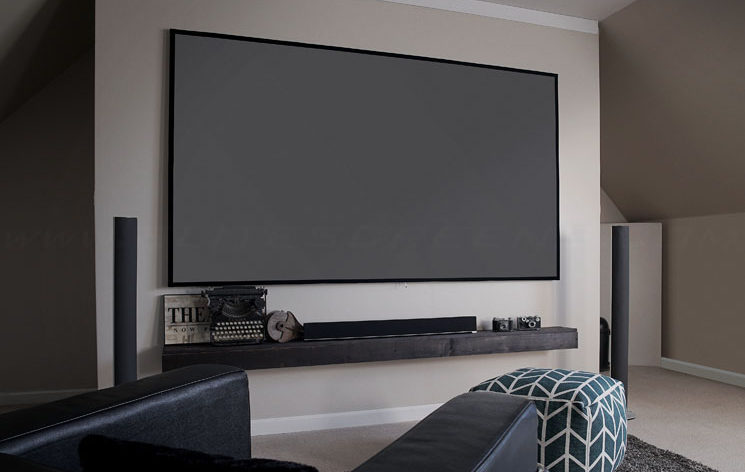When To Buy A Grey Projection Screen
If you spend any time in the home theater world, you’ll encounter home theater projectors. They promise massive pictures at prices that are inconceivable in flat panel displays (for now). Once you are convinced to get a projector, you need to choose a screen (you really do). You assumed that all screens are like the ones you’ve always seen – white. But then you stumble across a grey projection screen and people saying they are the thing everyone should buy. What’s up with them? Do you need a grey screen? Why is it even grey?
Why Do Grey Projection Screens Exist
As home theater projectors came down in price, people started wanting to put them in their homes (makes sense). When they left the realm of the ultra-rich people that wanted a dedicated screening room in their homes, projectors started being placed in regular rooms. And regular rooms have windows.
A quick way to kill your projector’s ability to present a good image is to let ambient light into your room. Once it hits the screen the image immediately washes out. Dedicated home theaters have complete light control (ideally). When you turn off all the lights in your room, whatever light is reflected off your projection screen is as “black” as the projector can get. In a room without complete light control, this will be some shade of grey. In a dedicated theater with full light control, you won’t be able to see the hand in front of your face.
Enter the grey projection screen. When people discovered that the blackest they could get their projector wasn’t actually black, they were disappointed. Screen manufacturers went to work and invented the grey projection screen for them to buy. These screens made it so that black once again looked black even in a room that didn’t have complete light control. Problem fixed, right? Well…
Author’s Note: Grey is not a Color
If you remember your 5th-grade science, you’ll know that white is all visible light reflected and black is the absence of reflected light. One common mistake people make is that if they buy a grey projection screen, the white light will always look grey. That is not the case. If you think of grey as dim white (or bright black), that is more accurate. When you see grey, you are seeing some of the white light reflected and some of it absorbed. It still reflects all the colors like a white screen, it is just not as bright. If you shine a bright white light on a grey surface, you don’t get bright grey. You get white.

The Sacrifice You Make for Blacker Blacks
When you buy a grey projection screen, you may be increasing the depth of the black levels, but at the expense of everything else. Colors will look more subdued, whites won’t be as bright, and the overall image will not be as saturated as you’d expect. This is, of course, if you are using the same projector using the same output.
Let’s pretend you are comparing a grey screen with 0.5 output to a white screen with 1.0 output. The output rating indicates what percentage of the light is reflected back. With the 0.5 grey projection screen, about half the light is coming back at you, with 1.0 white screen gives you 100% of the light. If you project a 500-lumen image on both screens, you’ll get an image that is half as bright on the grey screen. But the grey screen will also dim any ambient light that hits the screen by 50% while the white screen will reflect all of that as well.
“Well,” says you, “can’t I just make the image on the grey screen brighter to compensate?”
Yes, yes you can. But this isn’t without its costs. Running your projector in a brighter mode will lower the lifespan of your bulb. It’ll cause the projector to run hotter which may increase fan noise. Depending on your projector, running them at a higher brightness may decrease their contrast and accuracy as well.
Do You Really Need to Buy a Grey Projection Screen?
You may be thinking that your room has too much ambient light for a white screen. But does it? Could you not buy blackout curtains for your room? And what about your actual viewing habits? Do you really watch it very often during the day? Many people use their projectors primarily at night when even regular window shades are enough to blacken the room.
Also, think about the content you watch when there are lights on or during the day. It is sports and news? How much actual black content is there? Is it worth washing out your image at night (or forcing your projector into bright mode) just so that you get a slightly better image during the day?
Conclusion
The reality is that there are very good reasons to buy a grey projection screen. But there are equally good reasons why you shouldn’t. When making the decision on what type of projection screen to buy, you shouldn’t only look at whether or not you have windows in your room. Think about the projector you’ll have, how it will affect its performance,


